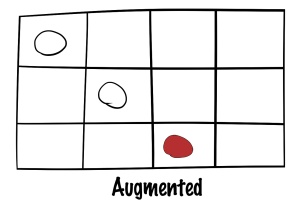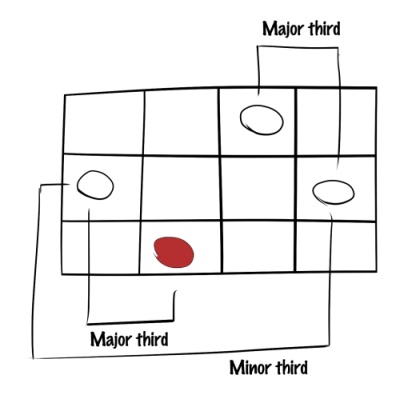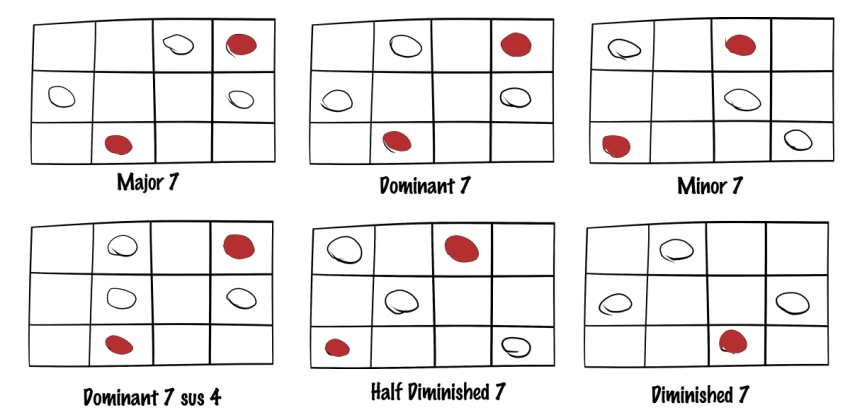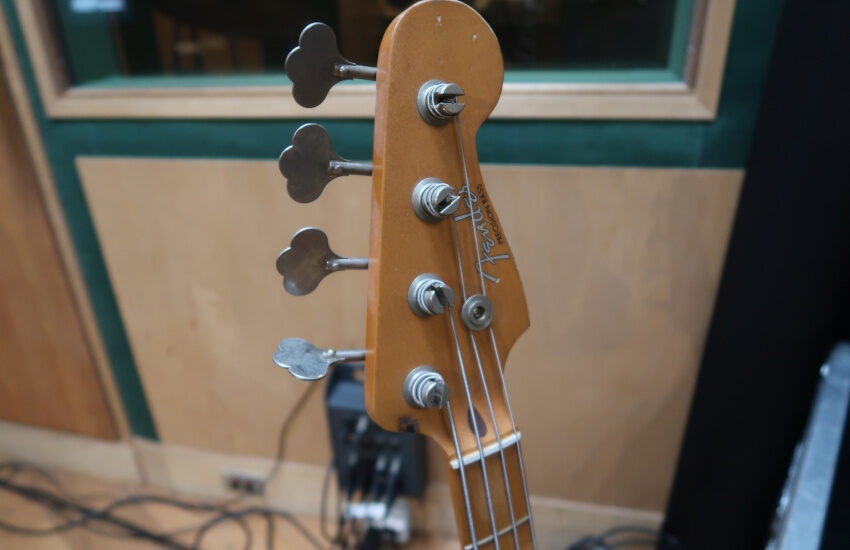As a bass player it is crucial to understand harmony and chords. After all, we are not only keepers of the groove, we also play a vital part in outlining the harmony so vocalists and lead players can really shine. Understanding how chords are created, makes us understand which notes are going to work over a chord and which notes to avoid. In our previous article we spoke about the three chord types you will encounter the most: Minor, major and diminished chords. This article helps you to understand two new chord types and also talks about how seventh and extended chords are built.
Augmented chords

One of the chords you rarely hear in pop music and has a very unique and mysterious sound, is the augmented chord. This chord is usually written (when C is the root note) as C+. Probably the most well-know use of this chord in pop music is in “Oh, Darling!” by the Beatles. You can hear it in the intro of the song. An augmented chord is a major chord with a sharp fifth. In other words, the chord formula is 1-3-#5. If you are not sure about the chord formulas anymore, or what the “#” indicates, be sure to check out/reread part 1 of this series.
Suspended chords

The second new chord type is the sus or suspended chord. In this chord the third (3rd) is replaced by the 2nd or 4th note from the scale. If the third is replaced by the 4th (and the root is C) the chord is written as Csus4 and has the chord formula 1-4-5. However, when the third is replaced by the 2nd note of the scale, the chord is written as Csus2 and has the chord formula 1-2-5. The reason it’s called a suspended chord is that it creates suspense for the listener. This is because the chord feels unfinished and our ears want to hear the 4th or 2nd resolve to the third of the chord.
Stacking thirds to expand chords

Now we have got those new chord types out of the way, it’s time to expand on what we already know. In the first article of this series we only talked about triads or three-note chords. However, to add color to chords, it is very common chord players add more notes to their chords. These aren’t just random notes, this all has to do with chord construction.
The way chords are constructed, is by stacking thirds. In a major chord the first note and the second note of the chord are spaced one major third apart, whilst the second and third notes of these chords are stacked a minor third apart.
Expanding on these chords means we would add notes to the chord exactly like we did in our triads, by stacking even more thirds on there!
How do seventh chords work?
By adding another third on our triad, seventh chords are born. Adding a major third to our major triad, creates a major 7 chord. Adding a minor third to our major triad however, will result in a dominant 7 chord. In this same way we can also stack thirds on our minor and diminished chords. The six seventh chords you will encounter the most are:
| Chord type | Chord Formula | Chord Symbol | Note in Chord |
| Major 7 | 1-3-5-7 | Cmaj7 | C-E-G-B |
| Dominant 7 | 1-3-5-b7 | C7 | C-E-G-Bb |
| Minor 7 | 1-b3-5-b7 | Cmi7 | C-Eb-G-Bb |
| Dominant 7 sus 4 | 1-4-5-b7 | C7sus4 | C-F-G-Bb |
| Half diminished 7 | 1-b3-b5-b7 | Cmi7b5 | C-Eb-Gb-Bb |
| Diminished 7 | 1-b3-b5-bb7 | Cdim7 | C-Eb-Gb-Bbb* |
*Note that a Bbb means you find your B note and lower it by two semitones. You might ask yourself why we wouldn’t just call this an A. It is called a Bbb because the note is originally a B but is flatted twice. It has the function of a seventh. The A in context to the C is a major 6th and thus has a different function.
To make the most out of this new found knowledge it is essential to focus on remembering the shapes that correspond with the chords. Try to identify the right shape whenever you encounter a chord. The shapes are as followed:

Extended chords: Building 9,11 and 13-chords
And it really doesn’t stop at 7th chords. We can stack another third and make it a ninth (9) chord, or stack another third and make it an eleven (11) chord and even stack another third and make it a thirteenth (13) chord.
“Wait, hold on. I thought a scale only has 8 notes, where is 9?” Good question! When we talk about these extended chords we extend beyond the octave, by repeating the notes that are in the scale. For practical use you could just grab every number above 8 and substract 7 from it to know which note is added:
For a C9 chord: 9-7=2; you add the major second beyond the octave to the chord which in C9 is a D: C-E-G-Bb-D
We can also flatten or sharpen these notes and get crazy chord symbols like C7b9#11. That looks scary doesn’t it? Actually it’s not that scary at all, once your understand how to read chord symbols. Once you do, they will tell you exactly what you need to know.
In the example of C7b9#11 we have a C7 chord, with a flattened nine (b9) and a sharpened eleven (#11). So the notes would be:
The 9th of the chord is: 9-7=2 which is a D
The 11th of the chord is: 11-7=4 which is an F
The next step after finding out what the 9th and the 11th of the chord are, is to sharpen and flatten them accordingly. So: The chord contains a major second which is flattened to make it a minor second (Db). It also contains a natural fourth which is sharpened to make it an augmented fourth (F#).
This means the notes for our C7b9#11 chord are: C-E-G-Bb-D#-F#
More practice on deciphering chord symbols

To practice understanding chord symbols a bit more we are going to use this chord progression. If we analyze the chords we can determine the following:
Fma7: This is an Fmajor7 chord. This symbol tells us that we are going to outline an F chord with a major 7. So the chord formula is 1-3-5-7. If the symbol was an F7, this chord would contain an Eb, but because the symbol defines it as a major 7, we know the chord contains an E.
Gmi7: This is a Gminor7 chord. In other words, we have a Gminor-triad with a minor7 added. The chord formula therefor is 1-b3-5-b7.
C7: We call this chord a C7 or a Cdominant7. It’s a Cmajor chord with a minor 7. The chord formula is 1-3-5-b7
Ami7b5: You would call this chord “A half diminished seven” or “A minor seven flat five”. This is our half diminished chord. As the name suggests we have a minor 7 chord, with a flatted five. The chord formula is 1-b3-b5-b7.
D7#9: D7 sharp 9. It’s just like our previous dominant chord, but it has a sharp nine added to it which makes the formula for this chord 1-3-5-b7-#9. The sharp 9 in this case is an E# because the major 2nd of the note D is an E. Note that when a piano player would voice this chord he would probably leave out the fifth.
If you have more elaborate chords like these, playing all these note at the same time really takes up a lot of space in the audio spectrum. You always want to leave some room in the arrangement for the other players. The fifth is the note in this chord that gives us the least information.
C9: You can call this chord Cdominant9 or C9. The chord formula is 1-3-5-7-9.
Getting down chord tones and shapes
As a bass player it is a very important skill to look at a chord and immediately know what notes and shapes are going to work over that specific chord. After all, that is how your bass lines are created! One way of practicing this when you are learning or writing a new tune, is to play all the notes that are in a certain chord separately. This also helps you to recognize their sound. It should be your goal to be able to play the correct shape that corresponds with every chord in a heart beat.
Most important goals when applying chord knowledge in order of importance
On Bass Essentials I talk a lot about what it means to be a good bass player. When it comes to reading a chord chart or playing through a song after learning the changes of a song .these are the concepts you should master in order of importance:
- Knowing where the roots are of every chord.
- Knowing if a chord is major and minor and playing the correct triad.
- Being able to play the seventh arpeggio over the chord.
- Being able to play any other extensions the chord has like the 9th, 11th or 13th.
- Being able to identify the function of the chord and to apply the corresponding mode that works over the chord.
I hope you found this article helpful! Let me know in the comments what your thoughts are and if you have any questions or suggestions.

